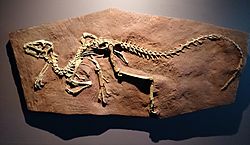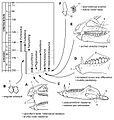Heterodontosaur facts for kids
Quick facts for kids HeterodontosaursTemporal range: Upper Triassic – Lower Cretaceous, 215–133 mya
|
|
|---|---|
 |
|
| Cast of the holotype specimen SAM-PK-K1332 of Heterodontosaurus tucki, Cape Town | |
| Scientific classification | |
| Kingdom: | |
| Class: | |
| Superorder: | |
| Order: | |
| Family: |
Heterodontosauridae
|
The Heterodontosauridae ("different-toothed lizards") were a family of early ornithischian dinosaurs. These dinosaurs are special because they had different kinds of teeth in their mouths.
Scientists once thought they were simple ornithopods, which are a group of plant-eating dinosaurs. But newer studies suggest they might be related to other groups, like marginocephalians. Even though their fossils are rare, these dinosaurs lived all over the world. They first appeared in the Upper Triassic period and might have lived until the Lower Cretaceous period.
Jaws and Teeth
Many ornithischian dinosaurs had a large gap in their upper jaw. This gap is called a diastema. It separated the front teeth (premaxillary teeth) from the main upper jaw teeth (maxilla). In heterodontosaurs, this gap was curved.
Their lower jaw, called the mandible, had a special bone at its tip. This bone, called the predentary, is only found in ornithischian dinosaurs. It helped support a beak, similar to the one on their upper jaw. All the teeth in their lower jaw were on the dentary bone.
Heterodontosaurids get their name because they had two very different kinds of teeth. They had three teeth in the front of their upper jaw. In early Jurassic dinosaurs like Abrictosaurus, Heterodontosaurus, and Lycorhinus, the first two front teeth were small and cone-shaped. But the third tooth was much bigger. It looked like the sharp canine teeth of meat-eating mammals. Because of this, it's often called a 'tusk' or caniniform tooth.
Classification
Early studies suggested that heterodontosaurs were very basic ornithischian dinosaurs. For many years, the main idea was that heterodontosaurids were simple basal ornithopods.
However, some scientists now think that heterodontosaurs might share a common ancestor with Marginocephalia. This group includes dinosaurs like ceratopsians (like Triceratops) and pachycephalosaurs (dome-headed dinosaurs). This idea is supported by some recent studies. A group, or clade, that includes heterodontosaurs and marginocephalians has been named Heterodontosauriformes. It's even possible that heterodontosaurs are more basic than both ornithopods and marginocephalians. In 2007, a cladistic analysis suggested that heterodontosaurs are more basic than all other known ornithischians, except for Pisanosaurus. This idea is similar to some of the very first studies on this dinosaur family.
Genera
- Abrictosaurus
- Echinodon
- Fruitadens
- Geranosaurus
- Heterodontosaurus (Type species)
- Lycorhinus
- Manidens
- Pegomastax
- Tianyulong
Images for kids
-
Life restoration of Fruitadens
-
Snouts of Heterodontosaurus (A), Abrictosaurus (B), and Tianyulong (C)
-
Holotype jawbone of Geranosaurus
-
Skull of Abrictosaurus
-
Biogeographic distribution of heterodontosaurids in time
-
Restoration of Pegomastax
See also
 In Spanish: Heterodontosáuridos para niños
In Spanish: Heterodontosáuridos para niños









